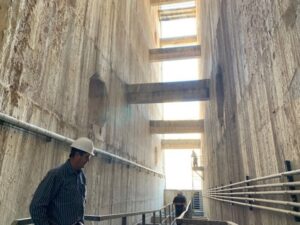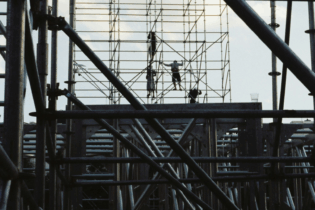With the era of large dam building having peaked in South Africa in the 1970s and many dams reaching their 50th anniversary, there is a growing focus on the correct and timeous maintenance and rehabilitation of the country’s dam infrastructure. Concrete can develop cracks, spalling and other forms of deterioration over time due to exposure to environmental factors like temperature fluctuations, movement, moisture, and chemical reactions.
“The concrete structures of many dams have undergone a natural ageing process over the decades,” comments Dr. Frank Denys, Technical Specialist: Dams at leading consulting engineering and infrastructure advisory firm Zutari. Dr. Denys is a member of several reference groups as part of the Water Research Commission (WRC), assisting in developing a national implementation strategy for sustainability and grey-green infrastructure. “The era of major dam building is definitely over in South Africa,” says Dr. Denys. This is due to the fact that most of the most feasible sites have already been developed. “The ageing concrete on the dams built in that era is a cause for concern, but it will not result in imminent structural failure. There is no significant risk of multiple dams suddenly failing and the country left with no water.” That said, concrete dam maintenance issues are not wholly dissimilar to the country’s current power generation and water infrastructure maintenance and development issues. The key is liberal maintenance spread out over time instead of major rehabilitation work, if necessary, every few decades. “Concrete ageing is part of that. If the concrete is looked after, you can be sure that the rest of the structure is well-looked. Thankfully, there is no imminent massive threat from an ageing perspective,” stresses Dr. Denys. “Every dam is treated as unique with its own set of requirements, so there is no generic way of fixing them,” points out Dr. Denys. However, there are certain ‘go-to’ solutions that tend to work well, especially related to advances in technology and concrete mixes. “We implement and apply these where the manufacturer or supplier feels it is appropriate. Time will tell in terms of the actual performance of the solution, whether newer technologies in the cement and concrete industry can stand the test of time.” Regular maintenance is needed to identify signs of distress, such as cracks, spalling, or leaks. These inspections detect issues early and prevent further deterioration. Dams also accumulate silt and debris over time, affecting their storage capacity and functionality. This requires regular dredging and sediment removal. “Sedimentation build-up is a related, but completely separate, issue. The storage capacity of dams is declining steadily due to this issue, resulting in catchment areas reduced from when these dams were originally planned. That is being looked at on a national scale by the WRC and the Department of Water and Sanitation. It is a very challenging issue that is also a global problem,” says Dr. Denys. Another issue is uncontrolled vegetation growth on dam surfaces, which can lead to cracks and damage. Thus, proper vegetation management is essential. Installing systems such as strain gauges, movement monitors, piezometers, and inclinometers can also greatly assist in monitoring dam behaviour and identifying anomalies over time.When it comes to refurbishment and rehabilitation challenges, structural repairs may be needed to address concrete cracks, spalling and other defects. Common techniques include epoxy injection, shotcrete application, and grouting. Applying protective coatings or cathodic protection systems can also mitigate corrosion of steel reinforcement.
Addressing seepage through the dam body or foundation is critical. Grouting, cutoff walls, and drainage systems can manage seepage. Lastly, upgrading instrumentation, emergency response plans, and spillway capacity is crucial to ensure dam safety. “Dams are designed to survive multiple decades. If they are well looked after, you can actually get a centuries-long lifespan out of them. This is vital as they supply all our major economic centres,” says Dr. Denys. While the major dams have fully-fledged engineering teams to support them, there are many smaller, but no less important, dams that are usually privately or municipally owned and mainly serve smaller towns. There is typically a lack of knowledge and expertise to carry out the necessary maintenance. “These dams are showing their age,” says Dr. Denys. The recent flood and drought cycle in Australia prompted a massive investment in dam refurbishment and upgrading. “We have not done that yet, but it is required. We did obviously have the Day Zero drought in Cape Town. They did not end up building a new dam there probably because most of the most feasible dam sites have already been taken. Instead, they are looking at innovative technological options like reusing effluent as their major contribution towards water security for the next several decades. “Definitely, other parts of the country will come next. Durban is not approaching its own Day Zero yet, but it is up for some challenging water supply issues over the next decade. Everyone can see it coming,” warns Dr. Denys. Here it is a combination of dam and water transfer-related infrastructure that has been massively neglected over time. “Again, it is the maintenance issue. The water transfer infrastructure has not been kept up to date, but it is also a water supply and availability issue,” he adds. Dr. Denys explains that there are different international approaches to dealing with ageing concrete dam structures and sediment build-up. For example, some US agencies actively decommission and totally remove such structures. “In South Africa and many other African countries, they are rather allowed to age gracefully. At the current stage, we are just raising awareness about the importance of maintenance and the fact that these structures must be looked after in the long term. That is critical,” he concludes.







